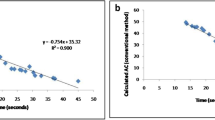Abstract
Amylose content (AC) is an important parameter responsible for the cooking quality of rice. Different methods with varied principles are being employed to determine the AC on the basis of their capacity of detection. Recently, our group successfully developed a simple and rapid method for AC determination termed as cut grain dip (CGD) method. In spite of the fact that this method is proved to be user friendly, thorough validation is required for its routine application across laboratories working on rice grain quality. To verify the accuracy of the CGD method, we compared this method with routine Juliano and two pure starch-based methods namely colourimetric and high-performance size-exclusion chromatography. A total of 16 rice varieties with varied amylose contents were used for the estimation of AC using the aforementioned methods. The results indicated that the CGD method showed high correlation (r) value of 0.987 (p < 0.01) with Juliano’s method. This method also showed significant correlation values of 0.849 (p < 0.01) and 0.869 (p < 0.01) with pure starch colourimetric and high-performance size-exclusion chromatography (HPSEC) methods, respectively. While the CGD method was able to discriminate the genotypes of all the three amylose classes, the pure starch-based colourimetric method could only discriminate high and low amylose genotypes and failed to detect the intermediate class. The findings of the present investigation indicate that the CGD method is not only rapid enough to screen large germplasm samples, but it also works with acceptable accuracy for its application in rice quality breeding.

Similar content being viewed by others
References
Agasimani S, Selvakumar G, John Joel A, Ganesh Ram S (2013) A simple and rapid single kernel screening method to estimate amylose content in rice grains. Phytochem Anal 24:569–573. doi:10.1002/pca.2433
Bao JS, Cai YZ, Corke H (2001) Prediction of rice starch quality parameters by near-infrared reflectance spectroscopy. J Food Sci 66:936–939. doi:10.1111/j.1365-2621.2001.tb08215.x
Batey IL, Curtin BM (1996) Measurement of amylose/amylopectin ratio by high-performance liquid chromatography. Starch-Starke 48:338–344. doi:10.1002/star.19960480907.
Chen M, Bergman CJ (2007) Rice grain vitamin-E homologs and g-oryzanol: effects of grain development and cultural practices. Rice Utilization Workshop Proceedings
Delwiche SR, Bean MM, Miller RE, Webb BD, Williams PC (1995) Apparent amylose content of milled rice by near-infrared reflectance. Cereal Chem 72(2):182–187
Demeke T, Hucl P, Abdel-Aal ES, Baga MM, Chibbar RN (1999) Biochemical characterization of the wheat waxy a protein and its effect on starch properties. Cereal Chem 76:694–698. doi:10.1094/CCHEM.1999.76.5.694
FAO (2004) “Rice is life”, Food and Agricultural Organization of the United Nations (http://www.fao.org/rice2004/en/f-sheet/factsheet3.pdf).
Grant LA, Ostenson AM, Rayas-Duarte P (2002) Determination of amylose and amylopectin of wheat starch using high performance size-exclusion chromatography (HPSEC). Cereal Chem 79:771–773. doi:10.1094/CCHEM.2002.79.6.771
Haase NU (1993) A rapid test procedure for estimating the amylose content of pea starch. Plant Breed 3:325–329. doi:10.1111/j.1439-0523.1993.tb00649.x.
Himmelsbach DS, Barton FE, McClung AM, Champagne ET (2001) Protein and apparent amylose contents of milled rice by NIR-Raman spectroscopy. Cereal Chem 78:488–492. doi:10.1094/CCHEM.2001.78.4.488
Hovenkamp-Hermelink JHM, DeVries JN, Adamse P, Jacobsen E, Witholt B, Feenstra WJ (1988) Rapid estimation of the amylose/amylopectin ratio in small amounts of tuber and leaf tissue of the potato. Potato Res 31:241–246. doi:10.1007/BF02365532
Hu G, Burton C, Yang C (2010) Efficient measurement of amylose content in cereal grains. J Cereal Sci 51:35–40. doi:10.1016/j.jcs.2009.08.007
IRRI (International Rice Research Institute) Report (2011) Agriculture and poverty in Asia. Manila, Philippines
Juliano BO (1971) A simplified assay for milled-rice amylose. Cereal Sci Today 16:334–340
Kim WJ, Eum CH, Lim ST, Han JH, You SG, Lee S (2007) Separation of amylose and amylopectin in corn starch using dual-programmed flow field-flow fractionation. Bull Kor Chem Soc 28:2489–2492. doi:10.5012/bkcs.2007.28.12.2489
Lumdubwong N, Seib PA (2000) Rice starch isolation by alkaline protease digestion of wet-milled rice flour. J Cereal Sci 31:63–74. doi:10.1006/jcrs.1999.0279
Mahmood T, Turner MA, Stoddard FL (2007) Comparison of methods for colourimetric amylose determination in cereal grains. Starch/Staerke 59:357–365. doi:10.1002/star.200700612
Mestres C, Matencio F, Pons B, Yajid M, Fliedel G (1996) A rapid method for the determination of amylose content by using differential scanning calorimetry. Starch-Starke 48:2–6. doi:10.1002/star.19960480103
Pedersen JF, Bean SR, Funnell DL, Graybosch RA (2004) Rapid iodine staining techniques for identifying the waxy phenotype in sorghum grain and waxy genotype in sorghum pollen. Crop Sci 44:764–767. doi:10.2135/cropsci2004.7640
Ward RM, Gao Q, de Bruyn H, Gilbert RG, Fitzgerald MA (2006) Improved methods for the structural analysis of the amylose rich fraction of rice flour. Biomacromolecules 7:866–876. doi:10.1021/bm050617e
Zhong F, Yokoyama WH, Wang Q, Shoemaker CF (2006) Rice starch, amylopectin and amylose: molecular weight and solubility in dimethyl sulfoxide-based solvents. J Agric Food Chem 54:2320–2326. doi:10.1021/jf051918i
Zhu T, Jackson DS, Wehling RL, Geera B (2008) Comparison of amylose determination methods and the development of a dual wavelength iodine binding technique. Cereal Chem 85:51–58. doi:10.1094/CCHEM-85-1-0051
Acknowledgments
The authors would like to acknowledge Monsanto’s Beachell-Borlaug International Scholars Program—2012 for their financial support to the first author to carry out this research work.
Author information
Authors and Affiliations
Corresponding author
Ethics declarations
Funding
This study was funded by Monsanto’s Beachell-Borlaug International Scholars Programme—2012.
Conflict of Interest
The authors declare that they have no conflict of interest.
Ethical Approval
This article does not contain any studies with human participants or animals performed by any of the authors.
Informed Consent
Not applicable.
Rights and permissions
About this article
Cite this article
Raja, R.B., Anusheela, V., Agasimani, S. et al. Validation and Applicability of Single Kernel-Based Cut Grain Dip Method for Amylose Determination in Rice. Food Anal. Methods 10, 442–448 (2017). https://doi.org/10.1007/s12161-016-0607-2
Received:
Accepted:
Published:
Issue Date:
DOI: https://doi.org/10.1007/s12161-016-0607-2




